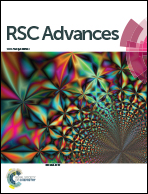pH responsive translocation of an anticancer drug between cyclodextrin and DNA†
Abstract
Ellipticine, a well known anticancer drug, emits intense green color when it is intercalated in DNA. It exhibits blue color inside the nano-cavity of a supramolecular host, γ-cyclodextrin (γ-CD). Inspired by these unique fluorescence switching properties of the anticancer drug, in the present work we have monitored the interplay of the drug between γ-CD and DNA by varying the medium pH as a stimulus. Here, steady-state and picosecond time-resolved fluorescence as well as circular dichroism techniques are employed to decipher the location of the drug inside the γ-CD nano-cavity and DNA. Our results confirm that at higher pH the drug selectively stays at γ-CD, even in the presence of biopolymers and exhibits blue color; whereas at lower pH, it is preferentially located in DNA even in the presence of γ-CD and emits a green color. We believe this kind of pH driven translocation of drugs monitored by fluorescence switching may find possible applications in controlled release of the drug inside cells.


 Please wait while we load your content...
Please wait while we load your content...